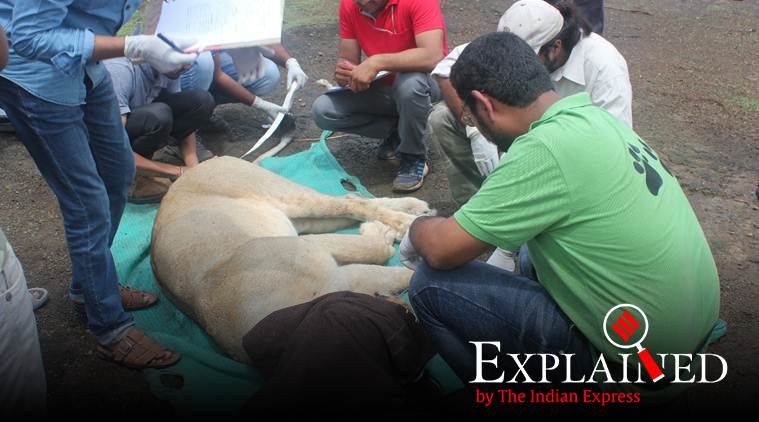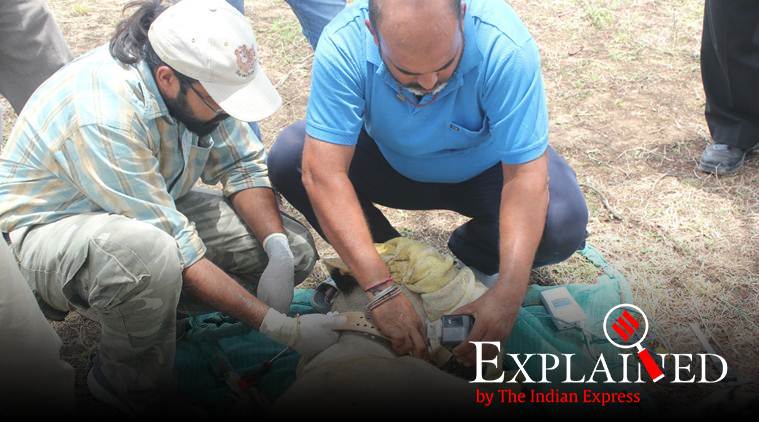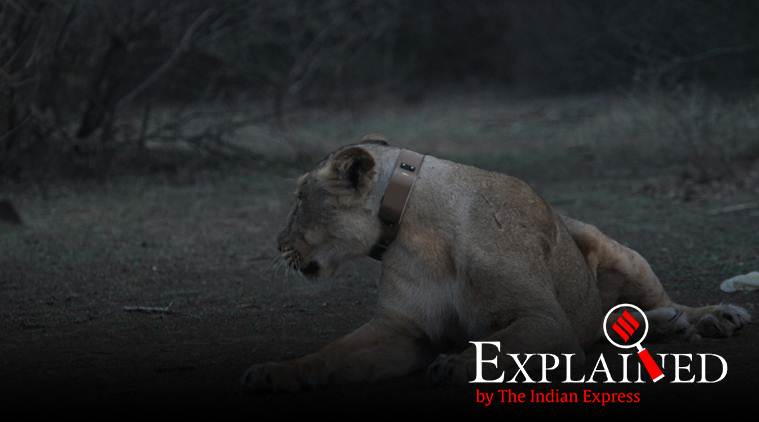


Forest officers in Gujarat say this is the largest project of its kind not only in the state but across the country. They say that it is for the first time that individuals of a single species are being radio-collared in such a large number.
What is the latest project of radio-collaring lions in Gir forest?
Gir National Park and other protected areas spread across Junagadh, Gir Somnath, Amreli, Bhavnagar and Botad districts in Saurashtra region of Gujarat, are the last abode of Asiatic lions in the world. In 2015, the forest department said that lion movement was recorded in 22,000 square kilometre area of the region and that the population of this endangered species was estimated to be 523.After the death of around two dozen lions due to the deadly canine distemper virus (CDV) in Dalkhaniya range of Gir (east) forest division in Amreli district in September last year, the state government had announced a Rs 350 crore-package to strengthen the conservation of the animal. Radio-collaring representatives of the entire population for the purpose of research and protection was one of the projects identified under this package.
Now, the state forest department has drawn plans to clamp radio-collars on 75 lions representing their territory. The forest department has imported these collars from Germany. On June 11, Chief Minister Vijay Rupani had launched the project by overseeing clamping of the first radio collar on a lion at Sasan, the headquarters of Gir National Park and Sanctuary (GNPS). Forest officers said they aim to clamp all the collars on the lions by the end of July.
Advertising
How will the project work?
As part of the project, the forest department is identifying representative lions in the area spread across five districts. After tranquilising them, it aims to clamp around their necks collars which are fitted with battery-powered chips. These chips will beam signals to the satellites at a preset frequency and the satellites, in turn, will relay the signals to a control-room in Sasan.At the same time, the signals generated from the chips in the collars will also be accessible on mobile VHF (very high frequency) receivers for the staff on the field to locate the animals.
Officers say that the individuals identified for radio-collaring include both males, females and sub-adult lions. As of June 24, the forest department has already radio-collared 25 lions.
The radio-collars come at a cost of Rs 6.78 lakh each and have a lifespan of around three years. The German suppliers have already trained staff of the Gujarat Forest Department on how to operate the collars.
Besides this, the German suppliers will also provide the services of satellite-linking. The radio-collars will help provide information like the location of an individual and its movement pattern, among others. On the basis of such information, the forest department will be able to plot a map of the territory of that individual.
The government has set up a high-tech monitoring unit at Sasan which will serve as control-room for the collars.
What is its importance?
Asiatic lions once used to range from the Middle East to many parts of the Indian subcontinent. However, due to rampant poaching and habitat loss, the population of the species had drastically reduced to just a few dozen individuals, restricted to Gir forest in Junagadh district by the 19th century.Thanks to the conservation efforts of the then ruler of the princely state of Junagadh and subsequently by the state forest department, the population of the big cats has recovered from the brink of extinction and has been growing steadily for the last four decades. It touched 523 in 2015.
While the sub-population today is divided among more than half-a-dozen meta-populations, they all are confined to a small geographical area and hence, some wildlife experts and conservationists say that the species is vulnerable to extinction in events of natural calamity or disease outbreak.
The CDV outbreak in 2018 was the biggest in the history of Gir forest and revived the argument of giving the big cats a second home away from Gir so that the species, which has been categorised as endangered by the International Union for Conservation of Nature, has better chances of survival.
In 2013, the Supreme Court had ruled in favour of the translocation of the Asiatic lions to Kuno-Palpur Sanctuary in Madhya Pradesh, reasoning such a move was necessary for the “interest of the species.” However, Gujarat has been mounting various challenges to the move even after the Apex Court verdict. The government has always argued that the lions are part of the culture of Gujarat and are safe in the state and that the forest department is doing everything it can for its conservation and protection.
However, the CDV outbreak underlined vulnerability. More importantly, of the 523 lions counted in 2015, 167 or around 32 per cent were living outside the protected forest areas. These lions were roaming in revenue areas where human activity remains high.
Gir forest, the core lion habitat, is surrounded by the human population. In such a mixture of forest and agro-pastoral landscape, man-animal conflict is obvious. Forest officers say the radio-collars will help them keep a track of the movement of lions and identify their corridors and territories. Such information will also help the forest staff take decisions regarding patrolling and protection of lions and thereby, help mitigate man-animal conflict.
Is there any precedence?
Until recently, Gir forest used to be the subject of a host of research projects. Scientists at Wildlife Institute of India and other researchers have tagged the Asiatic lions in the past. But the numbers of individuals they had radio-collared were small.Forest officers in Gujarat say this the largest project of its kind not only in the state but across the country. They say that it is for the first time that individuals of a single species are being radio-collared in such a large number, simultaneously.
The forest department has formed five teams, comprising veterinarians, wildlife trackers and forest guards for clamping radio collars on lions in all the five districts. The project is likely to cost the state government more than Rs five crore.
Will the collars have an adverse effect on the lions?
Not much, except the fact that it changes the natural look of the collared lions, says Bhushan Pandya, a well-known wildlife photographer and conservationist.https://indianexpress.com/article/explained/why-is-gujarat-forest-department-radio-collaring-lions-5797530/
No comments:
Post a Comment